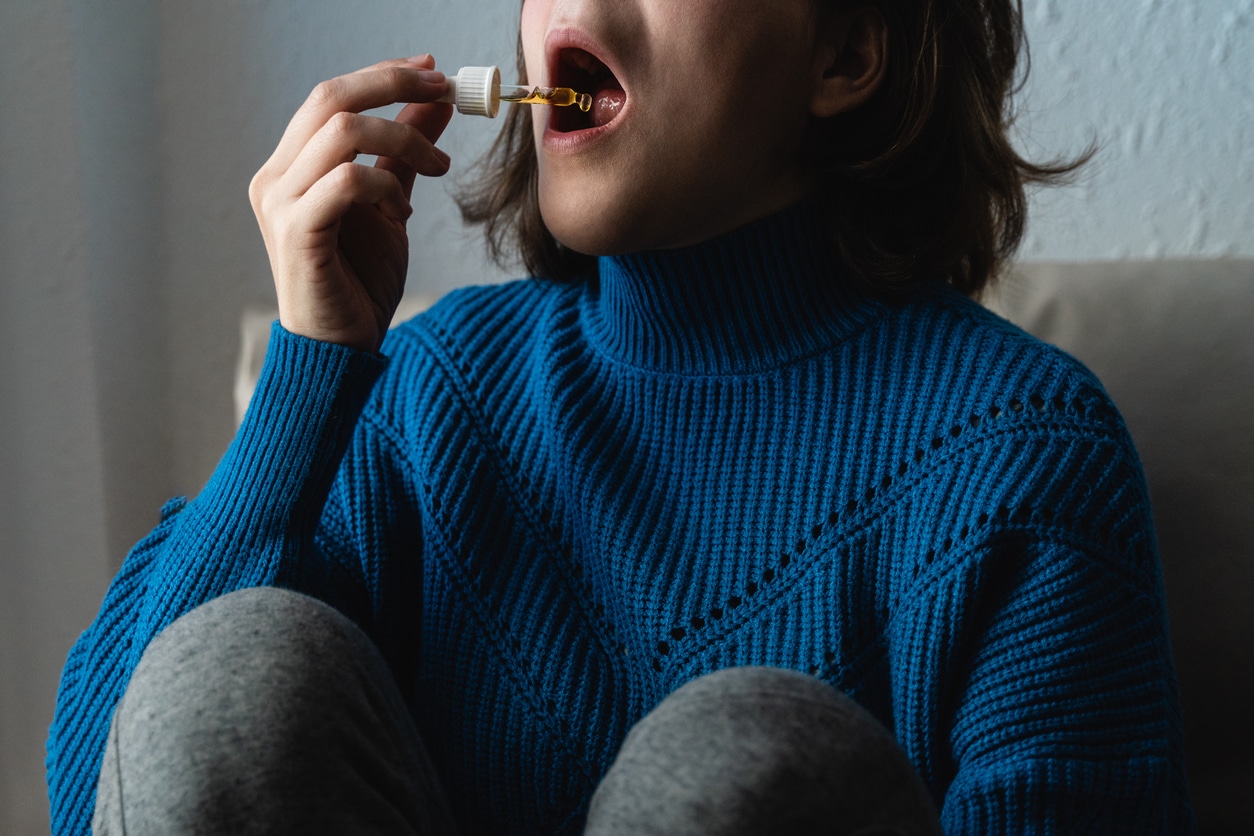Are you interested in exploring the world of cannabis beyond smoking or edibles? Have you heard about cannabis tinctures and wondered what they are and how they work?
People have used cannabis for medicinal and recreational purposes for centuries. With the legalization of cannabis in many places, more and more people are exploring its benefits. Cannabis tinctures are a lesser-known but highly effective way to consume cannabis.
If you are a beginner looking to explore cannabis tinctures, you’ve come to the right place. Mountain Annie’s can introduce you to cannabis tinctures and explain how they’re made, their benefits, and how to use them safely and effectively. Visit any of our stores, and our helpful budtenders will happily answer any questions.
What Are Cannabis Tinctures?
Cannabis tinctures are liquid extracts made from cannabis plants that contain a wide range of cannabinoids, terpenes, and other compounds found in the plant. They are typically created by soaking cannabis material in high-proof alcohol, such as ethanol, or using a carrier oil, such as MCT or coconut oil, to extract the active compounds. The resulting liquid can be consumed orally, sublingually (under the tongue), or added to food and beverages.
Tinctures are popular for medical cannabis patients and recreational users, as they offer a discreet and convenient way to consume cannabis without smoking or vaping. They also have a long shelf life and are easy to dose accurately.
Cannabis tinctures can be made with varying ratios of THC (tetrahydrocannabinol) and CBD (cannabidiol), depending on the desired effects. THC is the psychoactive compound responsible for the “high” associated with cannabis use. At the same time, CBD is a non-intoxicating compound with a range of potential therapeutic benefits, such as anti-inflammatory [1] and anti-anxiety properties [2]. Other cannabinoids and terpenes in the tincture can also contribute to the overall effects, often called the “entourage effect.”
How Do Tinctures Compare to Other Cannabis Products?
Tinctures offer some unique advantages compared to other cannabis products, as well as some differences in terms of onset, duration, and bioavailability. Here is a comparison of tinctures to other standard cannabis consumption methods.
Tincture vs. Smoking and Vaping
Cannabis flowers are typically consumed by smoking or vaping, whereas you take tinctures orally or sublingually. This makes tinctures a more discreet and odorless option, which is particularly helpful when consuming cannabis in public or shared spaces.
The effects of smoking or vaping cannabis are typically felt within minutes, while tinctures may take 30 minutes to 2 hours to take effect when ingested or 15-45 minutes when taken sublingually. The effects of smoking or vaping tend to last between 1-3 hours, whereas tinctures can last for 4-8 hours or more, depending on the dosage and individual metabolism.
Dosing is another aspect where tinctures have an advantage over cannabis flowers. Tinctures provide more precise dosing since you can easily measure them with a dropper or measuring tool. This allows users to control better the amount of cannabinoids they consume.
Finally, tinctures offer a healthier alternative to smoking and vaping, as they do not involve inhaling combusted plant material or vaporized oils, which can contain harmful byproducts. Inhaling smoke or vapor can introduce harmful byproducts into the lungs, which is not a concern with tinctures.
Tincture vs. Edibles
The onset of effects from tinctures and edibles is similar, taking around 30 minutes to 2 hours to kick in when ingested. The impact duration for both edibles and tinctures is generally longer than smoking or vaping, lasting between 4-8 hours or more.
Tinctures offer more precise dosing than edibles since you can easily measure them with a dropper or measuring tool. Furthermore, tinctures are virtually calorie-free, unlike edibles, which often come as sweet treats or baked goods.
Tincture vs. Topicals
The main differences between tinctures and topicals are their application, effects, and purpose.
Topicals include creams, balms, and salves applied directly to the skin. They provide localized relief for pain, inflammation, or occasional skin problems.
Cannabis topicals don’t typically enter the bloodstream, so their effects are limited to the area where they are applied. The onset of action for topicals is generally fast, as they start working as soon as the skin absorbs them. However, the duration of effects varies depending on the formulation and individual factors.
Conversely, you consume tinctures orally or sublingually, providing systemic effects throughout the body rather than localized relief. They also last longer and allow for precise dosing.
How Are Cannabis Tinctures Made?
Cannabis tinctures are made by extracting active compounds, such as cannabinoids and terpenes, from the cannabis plant. There are several methods to create tinctures, but alcohol-based and oil-based extraction are the two most common methods.
Alcohol-Based Extraction Methods
For alcohol-based extraction, makers soak cannabis plant material (flowers, leaves, or trim) in a high-proof alcohol, typically ethanol. The alcohol acts as a solvent, dissolving the cannabinoids, terpenes, and other compounds from the plant material. This process usually takes several weeks, with people occasionally shaking or stirring the mixture to facilitate the extraction.
Once the desired extraction time has passed, makers strain the mixture to separate the plant material from the liquid. The resulting tincture can be further refined by evaporating some of the alcohol, which increases the concentration of cannabinoids.
Oil-Based Extraction Methods
In oil-based extraction, a carrier oil, such as MCT (medium-chain triglyceride) or coconut oil, is used as a solvent instead of alcohol. Makers combine the cannabis plant material with the carrier oil and gently heated to facilitate the extraction of cannabinoids and terpenes. This process typically takes a few hours, and maintaining a low heat is crucial to prevent the active compounds’ degradation.
Once the extraction is complete, makers strain the mixture to remove the plant material, resulting in an oil-based cannabis tincture.
THC vs. CBD Ratios
The THC vs. CBD ratio in a cannabis tincture is not determined by the extraction method itself but rather by the cannabis plant material used. Both alcohol-based and oil-based extraction methods can yield tinctures with various THC and CBD ratios, depending on the strains or plant material used.
Cannabis strains have different genetic profiles, which lead to varying levels of THC, CBD, and other cannabinoids. To achieve a specific THC-to-CBD ratio in a tincture, choose the appropriate strain with the desired cannabinoid content. You may also combine strains or use a combination of high-CBD and high-THC strains to achieve a more balanced tincture.
Terpene Profiles
Terpenes are volatile organic compounds responsible for the aroma and flavor of cannabis. They also contribute to the plant’s therapeutic properties. Unlike the THC vs. CBD ratio, the extraction method used can affect the terpene profile of a cannabis tincture.
In alcohol-based extraction, high-proof alcohol, such as ethanol, is used. This is an effective solvent for extracting terpenes from cannabis plant material. However, because terpenes are volatile, they can be lost or degraded during extraction, particularly if you expose the mixture to heat or light. The lengthy extraction period required for alcohol-based tinctures can also contribute to terpene loss. To preserve terpenes during alcohol-based extraction, use airtight containers, store the mixture in a cool, dark place, and minimize heat exposure.
With oil-based extraction, carrier oils, such as MCT or coconut oil, may not be as efficient as alcohol in capturing the full spectrum of terpenes present in the plant material. The oil-based extraction process generally involves gentle heating, which can help preserve terpenes, but excessive heat can also cause degradation. To maintain terpene integrity during oil-based extraction, use low heat and avoid overheating the mixture.
Alcohol-based extraction is thus generally more effective at extracting terpenes, but it requires careful handling to prevent degradation. Oil-based extraction is gentler and may better preserve terpenes during the process, but it may fail to capture the full range of terpenes as efficiently as alcohol.
Benefits of Using Cannabis Tinctures
Cannabis tinctures offer several benefits, making them an appealing option for many users.
Precise Dosing
A key benefit of cannabis tinctures is their precise dosing capabilities. Users can easily measure the amount of tincture they want to consume with a dropper or measuring tool. This allows for better control over the dosage, which can be particularly important for users with specific dosage requirements.
A Healthier Alternative
Tinctures provide a healthier alternative to smoking or vaping, as they don’t involve inhaling combusted plant material or vaporized oils. Inhaling smoke or vapor can potentially introduce harmful byproducts into the lungs, which is not a concern with tinctures.
Rapid Onset of Effects
The onset and duration of effects are other factors that make tinctures appealing. When taken sublingually, tinctures can produce effects relatively quickly, usually within 15-45 minutes. When ingested, tinctures have a slower onset, typically around 30 minutes to 2 hours.
However, the effects of tinctures generally last longer than those from smoking or vaping, typically ranging from 4-8 hours or more, depending on the dosage and individual metabolism. This extended duration can be beneficial for those seeking long-lasting relief.
Discreet and Versatile
Tinctures are discreet and odorless. This makes them an ideal method of consumption for those who want to maintain privacy or use cannabis in public or shared spaces without drawing attention.
Cannabis tinctures are also highly versatile, as users can consume them in various ways. You can take them sublingually for faster absorption, ingest them directly, mix them with food and beverages, or even applied topically in some cases. This versatility allows users to tailor their cannabis consumption to their preferences and needs.
Finally, you can make tinctures with different ratios of THC and CBD. This lets users choose a product that meets their desired effects, whether they seek THC’s psychoactive properties, CBD’s non-psychoactive benefits, or a balanced combination of both cannabinoids.
Long Shelf-Life
Cannabis tinctures generally have a long shelf life, lasting anywhere from 1-3 years or more when stored properly. The shelf life of a tincture depends on factors such as the extraction method, type of solvent used, quality of the ingredients, and storage conditions.
Exposure to air can cause the tincture to oxidize, potentially affecting its potency and flavor. To prevent oxidation, use airtight containers, such as amber or cobalt glass bottles with droppers. You should also store the tincture in a cool, dark place such as a cupboard, pantry, or even the refrigerator.
Over time, the tincture’s potency may gradually decrease due to the natural degradation of cannabinoids and terpenes. Regularly check the tincture’s color, smell, and consistency to determine if it’s still suitable for consumption. If you notice any significant changes or signs of spoilage, it’s best to discard the tincture and obtain a fresh one.
Buy Cannabis Tinctures from Mountain Annie’s
People have used cannabis for medicinal purposes for centuries. With its legalization in many states, people are exploring the benefits of this fantastic plant.
For those new to the world of cannabis, tinctures may seem intimidating. However, they offer a discreet, long-lasting, and healthier alternative to smoking and vaping, with more precise dosing than edibles. They can also be an excellent choice for those seeking a versatile and easily controlled method of cannabis consumption. No wonder, then, that tinctures have become increasingly popular.
If you are a beginner to cannabis and are interested in trying tinctures, visit one of our four Colorado dispensaries, Ridgway, Silverton, Durango, and Cortez. Our budtenders will be happy to help you better understand tinctures. Once you feel confident incorporating them into your wellness routine, shop for our specials online and discover your new favorite cannabis tincture at one of our shops!
Resources
[1] https://www.ncbi.nlm.nih.gov/pmc/articles/PMC2828614/
[2] https://www.ncbi.nlm.nih.gov/pmc/articles/PMC6161644


